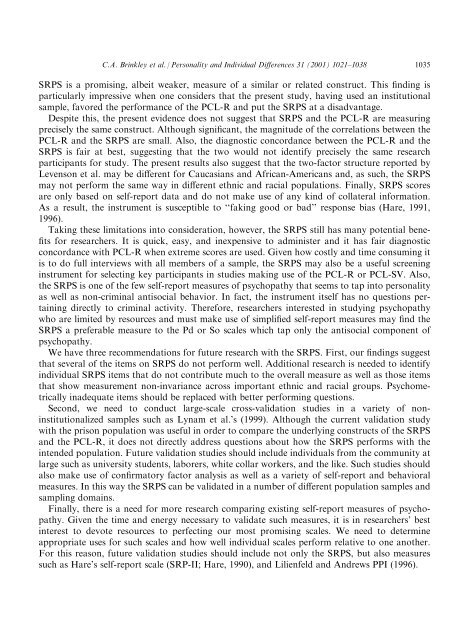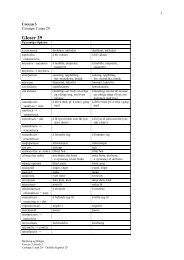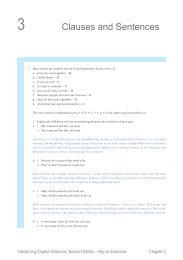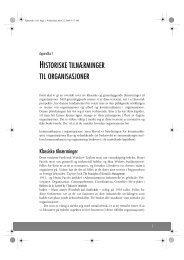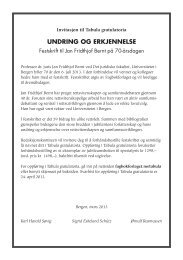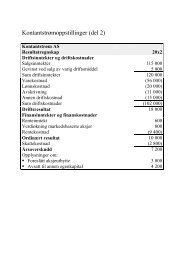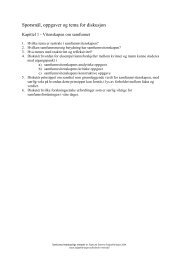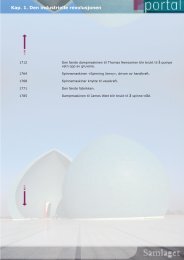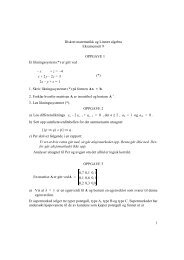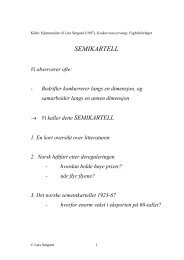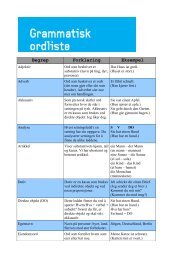Construct validation of a self-report psychopathy ... - Fagbokforlaget
Construct validation of a self-report psychopathy ... - Fagbokforlaget
Construct validation of a self-report psychopathy ... - Fagbokforlaget
You also want an ePaper? Increase the reach of your titles
YUMPU automatically turns print PDFs into web optimized ePapers that Google loves.
C.A. Brinkley et al. / Personality and Individual Di€erences 31 2001) 1021±1038 1035<br />
SRPS is a promising, albeit weaker, measure <strong>of</strong> a similar or related construct. This ®nding is<br />
particularly impressive when one considers that the present study, having used an institutional<br />
sample, favored the performance <strong>of</strong> the PCL-R and put the SRPS at a disadvantage.<br />
Despite this, the present evidence does not suggest that SRPS and the PCL-R are measuring<br />
precisely the same construct. Although signi®cant, the magnitude <strong>of</strong> the correlations between the<br />
PCL-R and the SRPS are small. Also, the diagnostic concordance between the PCL-R and the<br />
SRPS is fair at best, suggesting that the two would not identify precisely the same research<br />
participants for study. The present results also suggest that the two-factor structure <strong>report</strong>ed by<br />
Levenson et al. may be di€erent for Caucasians and African-Americans and, as such, the SRPS<br />
may not perform the same way in di€erent ethnic and racial populations. Finally, SRPS scores<br />
are only based on <strong>self</strong>-<strong>report</strong> data and do not make use <strong>of</strong> any kind <strong>of</strong> collateral information.<br />
As a result, the instrument is susceptible to ``faking good or bad'' response bias Hare, 1991,<br />
1996).<br />
Taking these limitations into consideration, however, the SRPS still has many potential bene-<br />
®ts for researchers. It is quick, easy, and inexpensive to administer and it has fair diagnostic<br />
concordance with PCL-R when extreme scores are used. Given how costly and time consuming it<br />
is to do full interviews with all members <strong>of</strong> a sample, the SRPS may also be a useful screening<br />
instrument for selecting key participants in studies making use <strong>of</strong> the PCL-R or PCL-SV. Also,<br />
the SRPS is one <strong>of</strong> the few <strong>self</strong>-<strong>report</strong> measures <strong>of</strong> <strong>psychopathy</strong> that seems to tap into personality<br />
as well as non-criminal antisocial behavior. In fact, the instrument it<strong>self</strong> has no questions pertaining<br />
directly to criminal activity. Therefore, researchers interested in studying <strong>psychopathy</strong><br />
who are limited by resources and must make use <strong>of</strong> simpli®ed <strong>self</strong>-<strong>report</strong> measures may ®nd the<br />
SRPS a preferable measure to the Pd or So scales which tap only the antisocial component <strong>of</strong><br />
<strong>psychopathy</strong>.<br />
We have three recommendations for future research with the SRPS. First, our ®ndings suggest<br />
that several <strong>of</strong> the items on SRPS do not perform well. Additional research is needed to identify<br />
individual SRPS items that do not contribute much to the overall measure as well as those items<br />
that show measurement non-invariance across important ethnic and racial groups. Psychometrically<br />
inadequate items should be replaced with better performing questions.<br />
Second, we need to conduct large-scale cross-<strong>validation</strong> studies in a variety <strong>of</strong> noninstitutionalized<br />
samples such as Lynam et al.'s 1999). Although the current <strong>validation</strong> study<br />
with the prison population was useful in order to compare the underlying constructs <strong>of</strong> the SRPS<br />
and the PCL-R, it does not directly address questions about how the SRPS performs with the<br />
intended population. Future <strong>validation</strong> studies should include individuals from the community at<br />
large such as university students, laborers, white collar workers, and the like. Such studies should<br />
also make use <strong>of</strong> con®rmatory factor analysis as well as a variety <strong>of</strong> <strong>self</strong>-<strong>report</strong> and behavioral<br />
measures. In this way the SRPS can be validated in a number <strong>of</strong> di€erent population samples and<br />
sampling domains.<br />
Finally, there is a need for more research comparing existing <strong>self</strong>-<strong>report</strong> measures <strong>of</strong> <strong>psychopathy</strong>.<br />
Given the time and energy necessary to validate such measures, it is in researchers' best<br />
interest to devote resources to perfecting our most promising scales. We need to determine<br />
appropriate uses for such scales and how well individual scales perform relative to one another.<br />
For this reason, future <strong>validation</strong> studies should include not only the SRPS, but also measures<br />
such as Hare's <strong>self</strong>-<strong>report</strong> scale SRP-II; Hare, 1990), and Lilienfeld and Andrews PPI 1996).


